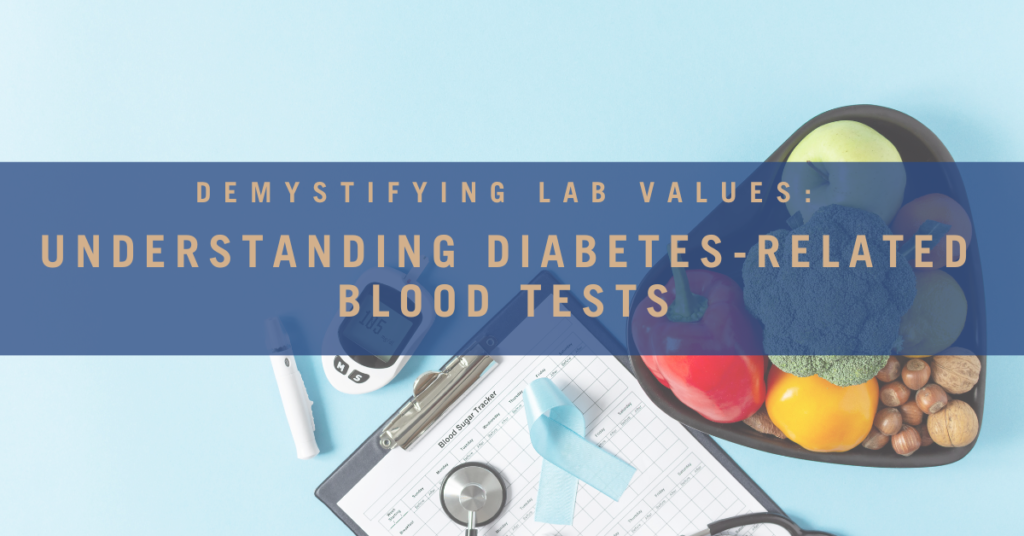Understanding Diabetes-Related Blood Tests

National Diabetes Month each November is an opportunity to raise awareness about diabetes and equip individuals with the baseline knowledge needed to understand the many diabetes-related blood tests a physician may order. Diabetes is a common chronic disease that impacts millions in the United States. According to the Centers for Disease Control (CDC), more than 37 million individuals have diabetes in America. This accounts for approximately 11.3% of the total population. Additionally, more than 96 million adults may meet the criteria for pre-diabetes and are at an increased risk for developing diabetes in the future.1
Understanding lab values can provide valuable insight into diabetes risk and management. Some of these labs are ordered for yearly physicals, and therefore, having a basic knowledge of what they measure and may indicate empowers individuals to respond accordingly.
Common Diabetes Monitoring and Diagnostic Tests
Hemoglobin A1c (HbA1c)
This test measures the average blood sugar (glucose) level over the past three months and is a critical indicator of long-term glucose control.2 The results are presented as a percentage, with lower percentages indicating better glucose control. An A1c of 4.5%, for example, corresponds to an average blood glucose of 82 mg/dL, whereas an A1c of 6.5% corresponds to an average blood glucose of 140 mg/dL. For a full conversion chart, visit the web page linked here.3 This test is often ordered for individuals who have diabetes, are over the age of 45, those who may be overweight, and those who may have risk factors for type two diabetes, such as a higher than average fasting blood glucose.4
- Normal: below 5.7%
- Prediabetes: 5.7%-6.4%
- Diabetes: 6.5% or above
Most physicians set a target A1c goal of 7% or less for their patients with diabetes. However, individual goals may vary depending on age, treatment modality, and coexisting conditions.4
Fasting Plasma Glucose (FPG)
The fasting glucose test measures morning glucose levels after an overnight, or eight-hour, fast. This test helps determine baseline blood sugar without food in the system to detect the presence of diabetes or prediabetes, or diabetes control in diagnosed individuals.5 This test is often ordered for what is called the “Basic Metabolic Panel” at a yearly physical. Other lab values on this test include calcium, sodium, chloride, carbon dioxide, potassium, creatinine, and blood urea nitrogen (BUN).6 Early detection through this test enables timely intervention, including lifestyle modifications and medications to manage or prevent diabetes effectively. If the fasting reading is elevated, a physician may then order an A1c to better understand average glucose over a longer period.
- Normal: below 100 mg/dL
- Prediabetes: 100 mg/dL to 125 mg/dL
- Diabetes: 126 mg/dL or above
Casual (Random) Plasma Glucose Test
This test is done at a random interval during the day to understand blood glucose at a given time. This means individuals can be fasted or have eaten somewhat recently.7 Readings over 200 mg/dL indicate the possible presence of diabetes and may warrant further exploration through a Fasting Glucose Test or HbA1c.7
Oral Glucose Tolerance Test (OGTT)
The Oral Glucose Tolerance Test assesses how the body processes or responds to glucose. After an overnight fast, you consume a glucose-rich beverage administered by the testing location. Blood sugar levels are then checked periodically to understand how the body is responding to the beverage.8 After two hours, blood sugar levels below 140 mg/dL are considered normal. Values between 140-199 indicate poor glucose tolerance, and values above 200 mg/dL may indicate the presence of diabetes.5
Interpreting diabetes-related blood tests is essential for understanding risk and for effective diabetes management. With the prevalence of diabetes and pre-diabetes in the United States, understanding risk empowers individuals to take charge of their health.
Interested in learning more about the role of nutrition, activity, and other lifestyle factors in diabetes prevention and management? A Summerfield dietitian is here to help! Contact the office at info@summerfieldcw.com today to learn more and schedule an appointment.
Sources:
- https://www.cdc.gov/diabetes/data/statistics-report/index.html
- https://diabetes.org/diabetes/a1c
- https://thegeriatricdietitian.com/hba1c-conversion-chart/
- https://www.cdc.gov/diabetes/managing/managing-blood-sugar/a1c.html#:~:text=Get%20a%20baseline%20A1C%20test,A1C%20test%20every%203%20years.
- https://diabetes.org/diabetes/a1c/diagnosis#:~:text=Fasting%20Plasma%20Glucose%20(FPG),in%20the%20morning%2C%20before%20breakfast.
- https://medlineplus.gov/lab-tests/basic-metabolic-panel-bmp/#:~:text=A%20BMP%20includes%20tests%20for,nerves%2C%20muscles%2C%20and%20heart.
- https://dtc.ucsf.edu/types-of-diabetes/type2/understanding-type-2-diabetes/basic-facts/diagnosing-diabetes/#:~:text=A1c-,Random%20or%20casual%20plasma%20glucose%20test,will%20not%20affect%20the%20test.
- https://www.ncbi.nlm.nih.gov/books/NBK279331/#:~:text=Oral%20glucose%20tolerance%20tests%20(OGTT,enough%20by%20the%20body’s%20cells.

